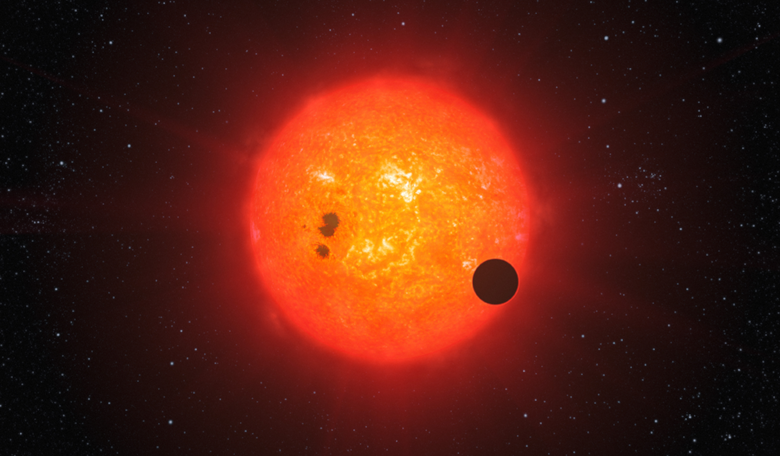Finding Earth-like planets around distant stars is notoriously difficult as it requires scientists to be able to distinguish the light from a small rocky world from the enormous amount of radiation pouring out from its stellar companion; it is essentially ike trying to see one of our Solar System planets in the daytime using only the naked eye.
But now a new technique that used the Low-Frequency Array, or LOFAR – a vast radio telescope network spread out over Europe – to pick-up radio emission from a nearby red dwarf has helped scientists find what could be an Earth-size planet in an approximately one- to five-day-long orbit circling its parent star.
Stars give off a lot of light over many different wavelengths; radio emission for example has wavelengths as short as millimetre and can stretch for as long as 100 kilometres! As such it takes a different kind of “telescope” to look for radio waves.
Instead of one huge telescope, like the type that optical telescopes use, radio telescopes are made up of many dishes or antennas spread over a wide area to collect the radio emission. This is because radio waves are a lot longer than visible-light waves, so the signals need to be collected in a different way.
LOFAR for example has about 20,000 small antennas concentrated in at least 48 stations, that when combined together give a total effective collecting area of approximately 300,000 square meters. For comparison, the size of the mirror tucked away on aboard the Hubble Space Telescope is around 2.4 metres.
Depending on the wavelength or frequency of the light from a star, scientists know what type of process is at work to make the light behave the way it does and for radio emission, the processes fall into two broad categories; incoherent emission and coherent emission, which in turn is based on how polarised the light is in that emission.
In general, a light wave can be thought of as vibrating in a vertical and in a horizontal plane. Unpolarised light, or light with a low degree of polarisation means the light wave is vibrating in all directions – it is incoherent. The opposite to this is coherent light, or light with a high degree of polarisation whereby the vibrations in the light wave occur in a single plane.
Over the years, scientists have found that outbursts of incoherent emission can last for hours at a time, whereas coherent emission on the other hand lasts only for seconds or minutes at a time. This latter emission is similar to the type of emission seen in solar radio bursts.
So far, most of the radio emission observed from distant stars is high frequency and it comes from a small class of magnetically active stars such as flare stars and close binaries. Searches for low-frequency radio emission has not been so fruitful. It has proven that difficult, only a single active flare star has been found to have emission of this type.
So, when astronomers came across a low-frequency signal from a quiescent red dwarf called GJ 1151, in data gathered from LOFAR’s Two-Metre Sky Survey (LoTSS), which was then cross-referenced against observations from the Gaia data release 2 database, the international team got straight to work investigating the cause behind the unusual radio signals.
According to the team’s research, headed by Harish Vedantham based at ASTRON, the Netherlands Institute for Radio Astronomy and published today in Nature Astronomy, the star’s radio emissions were unlike either of the two broad categories expected for stellar bursts at longer wavelengths.
While the signals persisted for longer than eight hours, which is typical of incoherent emission, it was also highly polarised - a trait seen in coherent emission. Instead the phenomena the signals most closely resembled was that of planetary auroral emissions; the type that is seen on Jupiter whereby extremely energetic electrons move at close to the speed of light close to the planet near its equator.
Radio aurorae are powered by large-scale electrical currents and after looking at the flux coming from GJ 1151, which is the closest catalogued star within the radio survey footprint, the team deducted it couldn’t be made by the star’s slow rotation.
Instead after running some simulations and taking into consideration the brightness of the star, the emission properties could be accounted for if an Earth-size planet was found to be whizzing around the red dwarf in a one to five day orbit and interacting with the plasma in GJ 1151’s magnetosphere.
Although it is more likely that the radio emission came from GJ 1151, it could have also been generated by the planet as an aurora and subsequently got caught up with emissions from the star, say the team.
Like any method of detecting exoplanets, generally the bigger a planet is, the easier it is to detect (not though it is very easy to detect a far-off world anyway) and the same goes for finding planets based on emissions from magnetic fields. Even though terrestrial planets are more commonly found around M dwarfs than gas giants, they are expected to have much weaker magnetic fields due to their relative size and so are harder to pinpoint.
This method used by Vedantham and colleagues, could therefore boost scientists chances of detecting smaller rocky worlds that orbit stars similar in temperament to our Sun. As the Sun is relatively quiet and not prone to too many destructive outbursts, this bodes well for planet’s where life is trying to get established.
“Based on the discovery of GJ 1151 in an ~420-square-degree survey footprint, we expect many tens of such detections from the ongoing LoTSS survey,” report the team in their paper. This will show that the interaction between stars and short-period exoplanets using their radio emission is a feasible method in which to detect Earth-like worlds around many different types of star.











